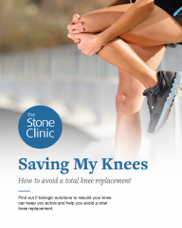Total Knee Replacement Surgery Rehab Protocol & Recovery Time
- All times are to be considered approximate, with actual progression based upon clinical presentation.
- Patients are weight bearing as tolerated with the use of crutches, a walker or a cane to assist walking until they are able to demonstrate good walking mechanics, then full weight bearing.
- Early emphasis is on achieving full extension equal to the opposite leg as soon as able.
- No passive or active flexion range of motion greater than 90 degrees until stitches are removed.
- Regular manual treatment should be conducted to the patella and all incisions so they remain mobile.
- Early exercises should focus on recruitment proper quadriceps set.
- No resisted leg extension machines (isotonic or isokinetic) at any point in the rehab process.
Week 1
- M.D./nurse visit after hospital discharge to change dressing and review home exercise program.
- Icing, elevation, and aggressive edema control (i.e. circumferential massage, compressive wraps).
Manual
- Soft tissue treatments and gentle mobilization to the posterior musculature, patella, and incisions to avoid flexion or patella contracture.
Exercises
- Initiate quadriceps/ gluteal sets, gait training, balance/ proprioception exercises.
- Straight leg raise exercises with proper quad set (standing and seated).
- Passive and active range of motion exercises.
- Well leg cycling and upper body conditioning.
Goals
- Decrease pain and edema.
- Range of motion <90 degrees (until stitches removed).
Weeks 2 - 4
- Nurse visit at 14 days for stitch removal and check-up.
Manual
- Continue with soft tissue treatments and gentle mobilization to the posterior musculature, patella, and incisions to avoid flexion or patella contracture.
Exercises
- Continue with home program, progress flexion range of motion, gait training, soft tissue treatments, and balance/proprioception exercises.
- Incorporate functional exercises as able (i.e. seated/standing marching, , hamstring carpet drags, hip/gluteal exercises, and core stabilization exercises).
- Aerobic exercise as tolerated (i.e. bilateral stationary cycling as able, upper body ergometer)
Goals
- Decreased pain and edema.
- Range of motion < 10 degrees extension to 100 degrees.
Weeks 4 - 6
- M.D. visit at 4 weeks.
Manual
- Soft tissue treatments and gentle mobilization to the posterior musculature, patella, and incisions to avoid flexion or patella contracture.
Exercises
- Increase the intensity of functional exercises (i.e. progress to walking outside, introducing weight machines as able).
- Continue balance/proprioception exercises (i.e. heel-to-toe walking, assisted single leg balance).
- Pool work outs once incisions completely closed.
Goals
- Gait without a limp.
- Range of motion < 5 degrees extension to 110 degrees.
Week 6 - 8
Manual
- Continue soft tissue treatments, joint mobilizations, patellar glides to increase range of motion.
Exercises
- Add lateral training exercises (i.e. lateral steps, lateral step-ups, step overs) as able.
- Incorporate single leg exercises as able (eccentric focus early on).
Goals
- Patients should be walking without a limp.
- Range of motion should be 0 to 115 degrees.
Weeks 8 - 12
Manual
- Continue soft tissue treatments, joint mobilizations, patellar glides to increase range of motion.
Exercises
- Begin to incorporate activity specific training (i.e. household chores, gardening, sporting activities).
- Low impact activities until week 12.
- No twisting, pivoting until after week 12.
- Patients should be weaned into a home/gym program with emphasis on their particular activity/sport.
Goals
- Range of motion with-in functional limits.
- Return to all functional activities.
NOTE: All progressions are approximations and should be used as a guideline only. Progression will be based on individual patient presentation, which is assessed throughout the treatment process.
Experiencing undiagnosed knee pain? Use our Knee Pain Symptom Checker to learn more about your symptoms and possible injury conditions.
Need help recovering from surgery? Our Stone Fit Physical Therapy San Francisco team can help with customized one-on-one programs to return you to full activity fitter, faster, and stronger than you’ve been in years.

